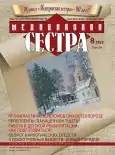Устойчивость лосиной мухи (Lipoptena cervi) к репеллентам
- Авторы: Куценко В.П.1, Ясынова А.Я.1, Ковалева Д.Д.1, Лустина О.М.1,2, Селиверстов П.В.3,2
-
Учреждения:
- ФГБОУ ВО «Санкт-Петербургский государственный педиатрический медицинский университет» Минздрава России Российской Федерации
- ВМедА им. С.М. Кирова
- ФГБУ «Национальный Медицинский Исследовательский Центр имени В.А.Алмазова» Минздрава РФ
- Выпуск: Том 24, № 8 (2022)
- Страницы: 26-31
- Раздел: Статьи
- URL: https://journals.eco-vector.com/0025-8342/article/view/233524
- DOI: https://doi.org/10.29296/25879979-2022-08-05
- ID: 233524
Цитировать
Полный текст
Аннотация
Оленья кровососка (Lipoptena cervi, L. 1758), также известная как «лосиная муха», «лосиная вошь», «deer ked» (англ.) - широко распространенный специализированный кровососущий паразит теплокровных, относящийся к семейству Hippoboscidae, отряду Diptera. Функции летающих особей заключается в поиске хозяина и расселении. Эта форма в цикле развития оленьей кровососки очень важна, если кровососка в течение нескольких дней не нападет на хозяина, она погибнет. Этим и объясняется ее активность и назойливость нападения, в том числе и на человека. Помимо причинения неудобств при контакте, лосиная муха является переносчиком трансмиссивных заболеваний, таких как болезнь Лайма, клещевой энцефалит, бабезиоз, риккетсиоз. На текущий момент в рамках профилактики и защиты от укусов лосиной мухи эффективных средств и мер не существует. Имеющиеся в широкой доступности для населения репелленты не обладают защитным эффектом от насекомого.
Ключевые слова
Полный текст
Об авторах
Валерий Петрович Куценко
ФГБОУ ВО «Санкт-Петербургский государственный педиатрический медицинский университет» Минздрава России Российской Федерации
Автор, ответственный за переписку.
Email: val9126@mail.ru
кандидат медицинских наук, доцент кафедры современных методов диагностики и радиолучевой терапии им. профессора С.А.Рейнберга
Айтан Явер кызы Ясынова
ФГБОУ ВО «Санкт-Петербургский государственный педиатрический медицинский университет» Минздрава России Российской Федерации
Email: leii3329@gmail.com
студентка
Дарья Дмитриевна Ковалева
ФГБОУ ВО «Санкт-Петербургский государственный педиатрический медицинский университет» Минздрава России Российской Федерации
Email: dasha753k@gmail.com
студентка
Ольга Михайловна Лустина
ФГБОУ ВО «Санкт-Петербургский государственный педиатрический медицинский университет» Минздрава России Российской Федерации; ВМедА им. С.М. Кирова
Email: val9126@mail.ru
старшая медицинская сестра 2-й кафедры (терапии усовершенствования врачей)
Павел Васильевич Селиверстов
ФГБУ «Национальный Медицинский Исследовательский Центр имени В.А.Алмазова» Минздрава РФ; ВМедА им. С.М. Кирова
Email: seliverstov-pv@yandex.ru
кандидат медицинских наук, доцент 2-й кафедры (терапии усовершенствования врачей); Старший научный сотрудник НИГ эпигенетики и метагеномики Института перинатологии и педиатрии
Список литературы
- Алексеев E.A. Первый опыт индивидуальной защиты человека от нападений оленьей кровососки Lipoptena ceroi Мед. Паразитология, №6, М., 1985. - С.56-57.
- Бахтушкина А.И. Выживаемость имагинальных форм оленьих кровососок (Diptera, Hippoboscidae) Российской паразитологический журнал. 2018., Т.12, №3. С.23-26. doi: 10.31016/1998-8435-2018-12-3-23-26.
- Березанцев Ю.А. О нападении оленьей кровососки (Lipoptena cervi L.) на человека. -Т 105. - СПб.: Тр. Военно-мед. Акад. Им. С.М. Кирова, 1959. -С.215-217.
- Буракова О.В. Обнаружение спирохет Borellia burgdorferi у мух-кровососок Lipoptena cervi L. (Diptera) Вестн. Моск. Ун-та. Сер. 16, биология, №1, 1999. - C.37-42
- Безерра-Сантос МА., Отранто Д. Кеде, загадочные мухи и их роль в качестве переносчиков патогенов. Acta Trop. 2020 Сен; 209:105521. doi: 10.1016/j.actatropica.2020.105521. Epub 2020 21 мая. PMID: 32447028.
- Басс M., Кейс Л., Кирни Б., Коулман С., ХеннингДж.Д. Выявление болезни Лайма и патогенов анаплазмоза с помощью ПЦР в Пенсильвании. J. Vector Ecol. 2016 Dec;41(2):292-294. doi: 10.1111/jvec.12225. PMID: 27860010.
- Виноградов-Волжинский Д.В. Практическая паразитология. Под ред. Д.В. Виноградова-Волжинского. Л., «Медицина», 1977. - с. 304.
- ГОСТ 59073-2020 Средства дезинсекционные. Общие технические условия. - М.: Стандартинформ, 2020 - с. 16.
- ГОСТ 59074-2020 Средства дезинсекционные. Методы определения показателей эффективности. - М.: Стандартинформ, 2020 - с. 32.
- ГОСТ Р. 59074-20 20 Средства дезинсекционные. Методы определения показателей эффективности. - М.: Стамдартинформ, 2020 - с. 35.
- 11. Досжанов Т.Н. К фауне мух-кровососок (Diptera, Hippoboscidae) Казахстана Изв. АН КазССР. Сер.биол. 1970., №5. - C.53-57.
- Иванов В.И. Распространение оленьей кровососки Lipoptena cervi L. (Diptera, Hippoboscidae) в Белорусской CCP, ее биология и вредоносность: автореф. Дис. канд. биол. наук. - Москва, 1981. - с. 23.
- Иванов В.И. О вредоносности оленьей кровососки Lipoptena cervi L. (Diptera, Hippoboscidae) в Белоруссии Паразитология, т. 8, №3, 1974. - C.252-253.
- Куценко В.П., Ясынова А. Я., Безвуляк Е.И., Лустина O.M., Селиверстов П.В. Лосиная Муха. Медицинская сестра 2022. 24(7): 36-40. doi: 10.29296/25879979-2022-07-08.
- МУ 3.1.3012-12 Сбор, учет и подготовка к лабораторному исследованию кровососущих членистоногих в природных очагах опасных инфекционных болезней. - М.: Роспотребнадзор, 2012. - с. 55.
- МУ 3.5.2.1759-03 Методы определения эффективности инсектицидов, акарицидов, регуляторов развития и репеллентов, используемых в медицинской дезинсекции. - М: Роспотребнадзор, 2003. - с.64.
- Попов А.В. Жизненный цикл мух-кровососок Lipoptena cervi L. и Stenepteryx hirundinis L. (Diptera, Hippoboscidae) Энтомол.Обозр.,- т. 44, №3, - 1965. - C.573-583.







